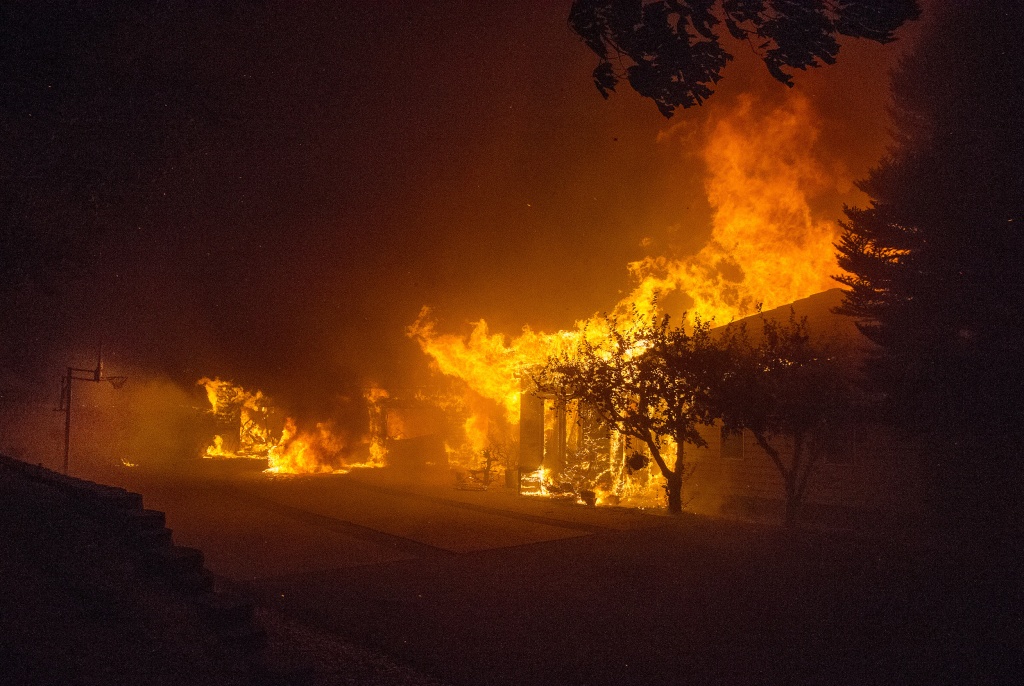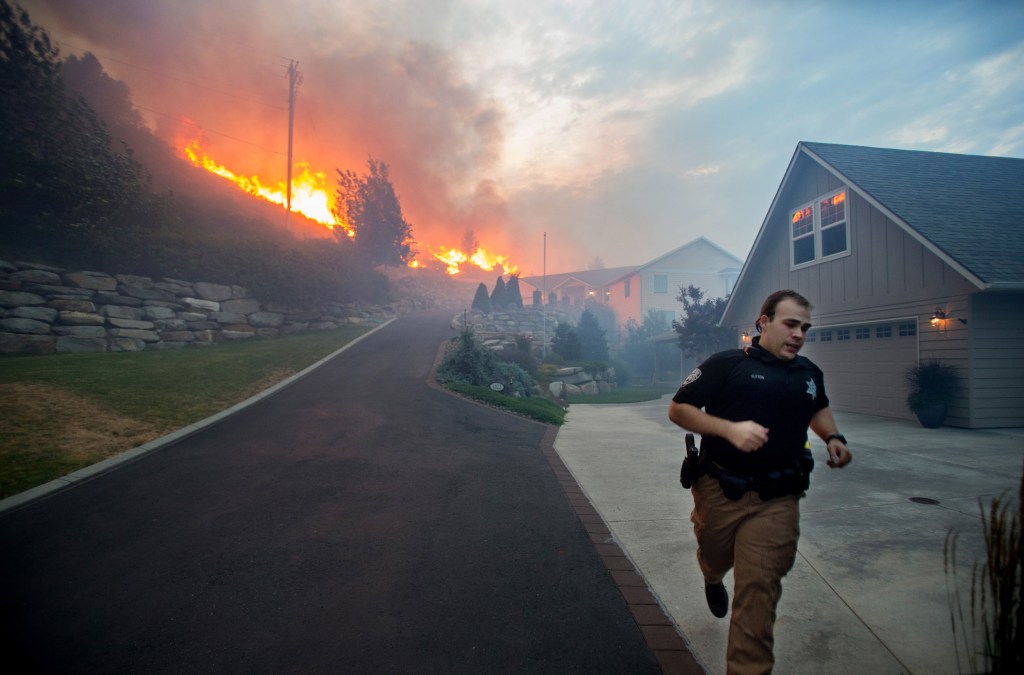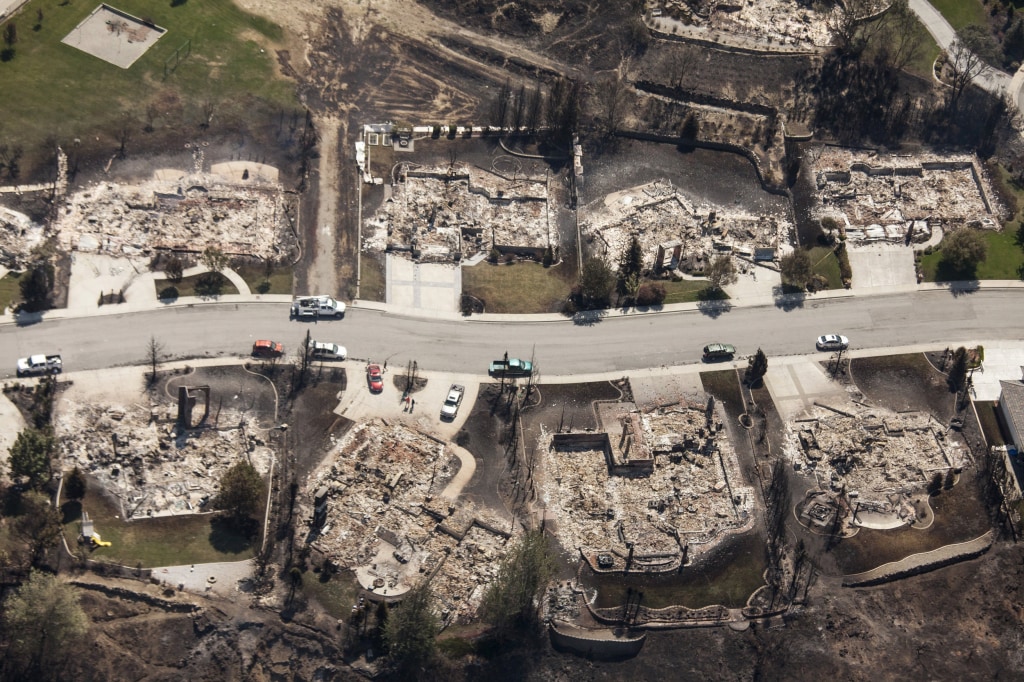'Heinous Act': Arson Blamed for One in Five California Wildfires
TO SEE VIDEOS;
Blame California's historic drought, extreme heat and Santa Ana winds for spreading wildfires faster than ever — but the blazes don't begin by themselves.
It takes a spark to set them, and in California last year, more than 1,000 wildfires were started intentionally. Since 2007, one in every five state wildfires was deemed arson, according to the California Department of Forestry and Fire Protection.
But investigators like Jennifer Ricci are helping to hunt down the culprits.
"We investigate all fires, and arson is one potential cause of many," said Ricci, adding, "There has to be an ignition source. That's our job — to figure out that ignition source."
Ricci is a CalFire battalion chief in San Bernardino County, but she's also a full-blown law enforcement officer — one of hundreds trained at a state academy in how to gather evidence, analyze data and determine the cause of a blaze.
Something as small as a piece of charred rock can help her identify where and how a fire started.
"I think you learn early in your career to separate the emotion," she told NBC News. "You have a job to do, and you do the job, and if you start letting emotions interfere, it can affect your judgment."
Just this week, CalFire law enforcement officers arrested a suspect accused of starting 11 wildfires in San Diego County since 2012.

"To commit arson during these drought conditions is an exceptionally heinous act and we will seek prosecution to the fullest extent under the law," said Chief Ken Pimlott, director of CalFire.
But author John MacLean says there's a deeper question burning.
"Why do (arsonists) do it?" he asked, rhetorically. "They do it because it is a way of asserting themselves in a powerful manner when their lives are powerless."
MacLean extensively researched the 2006 Esperanza Fire in Southern California — one of the state's worst arson wildfires. Five firefighters were killed, and the person who set the blaze was convicted of murder.
Arson's consequences can be deadly, and are almost always devastating. It's why investigators like Ricci say they will tenaciously investigate the cause of every single wildfire.
Once a blaze begins, there's no telling how far it can spread.
"All fires are destructive," said Ricci, adding, "Whatever causes that fire, the end result is the same. The fire doesn't know the difference."
As wildfire season heats up in the western United States, communities on the front lines are relying on aircraft — from nimble helicopters with night vision to lumbering tankers that date back to World War II — to keep conflagrations from morphing into catastrophes.
Air attacks are often the fastest and sometimes the only way to fight the blazes that are threatening countless homes and lives during this dry, hot beginning to the summer.
But crucial as they are, many of these firefighting planes aren't exactly state-of-the-art. Some of the air tankers — which dump water or flame retardant on fires — are more than a half-century old.
"This is the third generation of old military aircraft that have ended up causing multiple deaths," Jim Hall, former head of the National Transportation Safety Board, said in 2012.
A C-130 battling a California blaze in 2002 went down after its wings separated from the body, killing all three on board. Last year, a CalFire air tanker, made in 2001, crashed in a canyon in Yosemite National Park.

The Orange County Fire Authority in southern California relies on a more nimble fleet — a squadron of four helicopters that hold 375 gallons of water and come with a $2 million annual budget.
"These helicopters are worth their weight in gold because they can get up quickly and they can suppress a fire within minutes," said Capt. Steve Concialdi, a spokesman for the agency.
"If it saves one or two homes from burning, it has basically paid for itself for the entire year," Concialdi said. "Because when we get a fire that starts burning homes, the price tag to fight that fire gets into the millions of dollars."
The authority green-lighted a pilot program this year to keep helicopter crews staffed around the clock. Pilot Ethan Jensen said that gives Orange County a big edge.
"If a fire starts at 1 a.m. in the morning, traditionally there wouldn't be any aircraft on it until 7 or 8 o'clock in the morning and it's already had six or seven hours to get a head of steam on it," he said. "Now with the initial attack on it being at night, we can be on the fire hopefully while it's still small.
"If we can get on the scene when the fire's still relatively small, less than an acre or two ... that can make a huge difference in whether it stays small or if it becomes a large extended attack fire that can do days or even weeks."

Two NOAA photos show the progression of Canadian smoke cover over Western Washington. Courtesy National Oceanographic and Atmospheric Administration
Thick, heavy smoke blanketed large areas of British Columbia and churned across the border Monday — leading to health advisories across the U.S. West and Midwest— as firefighters battled 89 new wildfires across the province, Canadian officials said.
The new fires, all of which have started since Friday, brought to 184 the number of active blazes across the western province, the B.C. Ministry of Forests, Lands and Natural Resources Operations said Monday.
One of the fires, dubbed the Elaho Valley fire, in the Pemberton Valley north of Whistler, had grown to cover more than 77 square miles by Monday afternoon, the B.C. Wildfire Service said.
"This fire is displaying a vigorous and aggressive rate of spread, the service's Wildfire Management Branch said in a statement. "This type of fire behaviour consumes timber completely through to the tree tops, and ... poses a safety risk for ground crews and aircraft conducting fire suppression efforts."
Much of the province is under an "extreme" fire rating, Forests Ministry said, and more than 800 homes have been ordered evacuated.

Air quality warnings spread across British Columbia south to Colorado and east to Minnesota as the smoke drifted across North America.
The National Weather Service in Seattle said a smoke plume covered a large part of Vancouver Island down the west side of Washington state's Olympic Peninsula.
Various levels of air quality alerts attributed specifically to the Canadian fires the covered the entire state of Minnesota; large parts of North Dakota, South Dakota, eastern Nebraska, Iowa, Illinois and Missouri; northeastern Colorado; and much of western and central Washington.
"The smoke from these fires has risen above 20,000 feet, and the jet stream has been acting like a highway and transporting that smoke all across the country," said Dustin Bonk, a meteorologist for NBC station WILX of Lansing Michigan.
The National Weather Service smoke from Canada had been recorded all the way to the U.S. Atlantic Coast. While it hasn't been heavy enough that far out to cause health concerns yet, it has blessed residents with some fiery red sunrises and sunsets.
Because the smoke was moving primarily east-southeast, the biggest U.S. impact is in Minnesota, where the state Pollution Control Agency said that "fine particle levels had reached unhealthy levels in a diagonal band across the state," which is "expected to continue to move across the state Monday evening and into the early morning hours Tuesday."
B.C. Forests Minister Steve Thomson said at least 40 of the provincial fires were human-caused. So far, the province has spent $80 million fighting the fires, with no end in sight, he said.

Washington Wildfire Consumes Homes and Businesses
The Sleepy Hollow fire roared through Wenatchee, Washington, destroying homes and businesses, and creating dangerous conditions for many.

. A Douglas County firefighter sprays down the back of a home on Quail Hollow Lane in Wenatchee, Washington, trying to protect it from burning embers flying off of a neighboring house on fire on June 28, 2015.
The Sleepy Hollow fire, a fast-moving Washington wildfire, sparked Sunday afternoon and rapidly spread to 3,000 acres, leading to the evacuation of several hundred homes in the path of the fire. Don Seabrook / Wenatchee World
The Sleepy Hollow fire, a fast-moving Washington wildfire, sparked Sunday afternoon and rapidly spread to 3,000 acres, leading to the evacuation of several hundred homes in the path of the fire. Don Seabrook / Wenatchee World

. A house is completely engulfed in flames near Horse Lake Road in Wenatchee on Sunday night as a brush fire spread from Monitor and into neighborhoods on the outskirts of Wenatchee. Don Seabrook / Wenatchee World

. Forest Service fire fighters from Leavenworth cut brush near houses in northern Wenatchee on June 28 as a brush fire moves near a neighborhood. Don Seabrook / Wenatchee World

. A Chelan County sheriff deputy races to check that all residents have left their home as flames approach houses at Quail Hollow Lane in Wenatchee on June 28. Firefighters went from door to door to urge residents to evacuate. Don Seabrook / Wenatchee World

. Smoke from burning commercial buildings that were ignited by the Sleepy Hollow fire rises above Wenatchee, on June 29. David Ryder / Reuters

. Homes destroyed by the Sleepy Hollow fire are pictured in Wenatchee on June 29. The wildfire burning unchecked in central Washington state has destroyed at least 23 homes and three commercial buildings near the eastern foothills of the Cascades, state police and emergency management officials said on Monday. David Ryder / Reuters

. Homes destroyed by the Sleepy Hollow fire are pictured in Wenatchee on June 29. The fire is now partially contained, but parts of Wenatchee continue to burn.
•Read more:Washington Wildfire Burns 3,000 Acres, Destroys Two Dozen HomesDavid Ryder / Reuters
•Read more:Washington Wildfire Burns 3,000 Acres, Destroys Two Dozen HomesDavid Ryder / Reuters
A fast-moving Washington wildfire that consumed at least two dozen homes as it jumped from roof to roof is now partly contained, authorities said Monday, but parts of Wenatchee continue to burn.
The Sleepy Hollow Fire, about 140 miles east of Seattle, sparked Sunday afternoon and had spread to 4,000 acres Monday afternoon, leading to the evacuation of several hundred homes in its path.
Meanwhile, new worries about an ammonia leak at a nearby fruit packaging facility Monday led authorities to issue a shelter-in-place order for parts of the town. But the threat dissipated quickly, and the order was lifted early in the afternoon.
Dry conditions and gusting winds fed the blaze, which consumed a cardboard recycling facility. An ember flew through the window of a firefighter's car, burning part of the back seat, authorities said. A rain shower helped slow the blaze Monday morning.
PHOTO GALLERY: Wildfire Consumes Homes and Businesses
Firefighters went door to door to urge residents to evacuate. Just more than 200 took shelter at Eastmont High School on Sunday night.
Maribeth Marboe was given 30 minutes Sunday night to evacuate her home on Maiden Lane. With the help of neighbors and family, she grabbed all the photos and files from her office and fled the neighborhood where she'd lived for 17 years.
Her husband, Scott, son, Michell, and friends stayed back a bit longer to battle the fire, but they were forced to flee after about 40 minutes.
And her home? "It's completely gone," Marboe told NBC News on Monday, along with about a dozen more in her area, known as Broadview.
The destruction happened quickly in an area known for dry brush, which has been threatened by wildfires in the past.
Marboe arrived at her home at 2:30 Sunday and saw a fire on a hill in the distance. She described how she called 911 and was told not to worry, that it was too far away. "But the wind shifted, and the police were out here, said it was Level 3 and to get out now."
As officials tried to determine what sparked the fire, Chelan County emergency management officials declared a state of emergency. The Northwest has experienced a stretch of arid weather and is expected to suffer from torrid heat well into July, The Weather Channel reported, raising the specter of an earlier and more dangerous fire season.



No comments:
Post a Comment
Please leave a comment-- or suggestions, particularly of topics and places you'd like to see covered